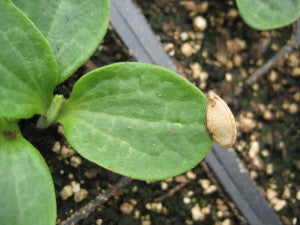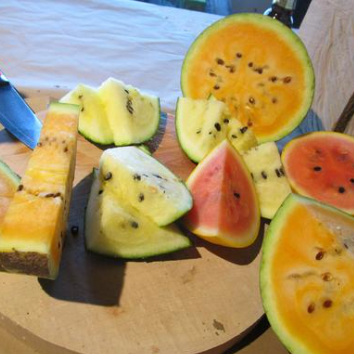 Mother’s Day has come and gone. For gardeners in our region, this date means a tenuous sigh of relief: we have officially passed our last frost date. Although late spring frosts happen, the chances are small enough to make the risk of direct-sowing tender crops (and hardening tender transplants) worth it. Mid-May is the entrance gate into the summer garden – welcome!
Mother’s Day has come and gone. For gardeners in our region, this date means a tenuous sigh of relief: we have officially passed our last frost date. Although late spring frosts happen, the chances are small enough to make the risk of direct-sowing tender crops (and hardening tender transplants) worth it. Mid-May is the entrance gate into the summer garden – welcome!
Warm season tender vegetables (unlike hardy or semi-hardy varieties) are intolerant of frost. At a minimum, they ask for temperatures above 60 during the day, but prefer a hotter range - between 70 and 100. A week of below 60 weather may stunt their growth. All the quintessential crops of summer fall into this category: beans, corn, cucumbers, melons, okra, squash, tomatillos, tomatoes, ground cherries, eggplants, peppers.
Some crops, namely tomatoes, eggplants, peppers, and okra need a longer warm season than our region provides, and so must be sown indoors in early spring to get a jump on the season. All other tender crops, can be sown directly in the garden after danger of frost has passed. Here’s how:
All crops covered here have big seeds, which makes spacing easy at planting time, with little need for thinning. Consider sowing them a little thicker than ideal, just in case, but no need to scatter extensively.
Bush beans are bean varieties that grow somewhat low to the ground and branch out extensively – they don’t need trellising. For a continual harvest (and extras to preserve for winter!), sow beans every three weeks all season, until 8 weeks before first fall frost.
 Corn grows quickly and vigorously, but has a couple of special requirements. It occupies a lot of space and only produces a few ears per plant and so, could be a tricky crop in a small garden (a small variety, such as Jade Blue Dwarf Sweet Corn works best for small spaces or containers). The second consideration is pollination. Corn relies on the wind to carry its pollen from the tassels to the silks of the young ears in order to produce a cob full of kernels. To help this process, corn is best planted in short rows within a square, each plant spaced one foot apart. (Look for our article on growing corn in the coming weeks).
Corn grows quickly and vigorously, but has a couple of special requirements. It occupies a lot of space and only produces a few ears per plant and so, could be a tricky crop in a small garden (a small variety, such as Jade Blue Dwarf Sweet Corn works best for small spaces or containers). The second consideration is pollination. Corn relies on the wind to carry its pollen from the tassels to the silks of the young ears in order to produce a cob full of kernels. To help this process, corn is best planted in short rows within a square, each plant spaced one foot apart. (Look for our article on growing corn in the coming weeks).
 Cucumbers and Summer Squash are sprawling vines that could either grow along the ground or be trained to climb up a trellis. For some varieties, like the long and slender Yamato Sanjako Cucumber for example, trellising is preferable, while for other types, it’s easier to spread vines horizontally. Cucurbits need pollinators to set fruit, so be sure your garden is an appealing habitat for them. To enjoy harvests all season, sow in succession up to 12 weeks before first frost. Pick often to encourage more fruit! For detailed growing instructions, take a look at Erin’s post on Summer Squash.
Cucumbers and Summer Squash are sprawling vines that could either grow along the ground or be trained to climb up a trellis. For some varieties, like the long and slender Yamato Sanjako Cucumber for example, trellising is preferable, while for other types, it’s easier to spread vines horizontally. Cucurbits need pollinators to set fruit, so be sure your garden is an appealing habitat for them. To enjoy harvests all season, sow in succession up to 12 weeks before first frost. Pick often to encourage more fruit! For detailed growing instructions, take a look at Erin’s post on Summer Squash.
 Melons and Watermelons have similar growing preferences to other cucurbits (like squash and cucumbers) but can be a little more finicky. Wait two weeks after last frost before planting. Melons grow fine in rows, but many varieties grow even better in hills. For more information on growing in hills, take a look at these Melon tips from Cornell University. Melons are sensitive to moisture and susceptible to fungal diseases – plant them in the sunniest and breeziest part of your garden. There are many theories for when melons are ready for harvest: some knock watermelons and pluck them when they hear a solid thud, as opposed to a hollow ring. Some judge cantaloupe or musk melon’s ripeness by their fragrant smell alone. Others go by the color palette of the side of the fruit resting on the ground: once it turns pale, it’s ready. We usually go by the stem: if the fruit dis-attaches from the stem with no effort or if the stem is fully dry, it’s ready to be homemade dessert!
Melons and Watermelons have similar growing preferences to other cucurbits (like squash and cucumbers) but can be a little more finicky. Wait two weeks after last frost before planting. Melons grow fine in rows, but many varieties grow even better in hills. For more information on growing in hills, take a look at these Melon tips from Cornell University. Melons are sensitive to moisture and susceptible to fungal diseases – plant them in the sunniest and breeziest part of your garden. There are many theories for when melons are ready for harvest: some knock watermelons and pluck them when they hear a solid thud, as opposed to a hollow ring. Some judge cantaloupe or musk melon’s ripeness by their fragrant smell alone. Others go by the color palette of the side of the fruit resting on the ground: once it turns pale, it’s ready. We usually go by the stem: if the fruit dis-attaches from the stem with no effort or if the stem is fully dry, it’s ready to be homemade dessert!





